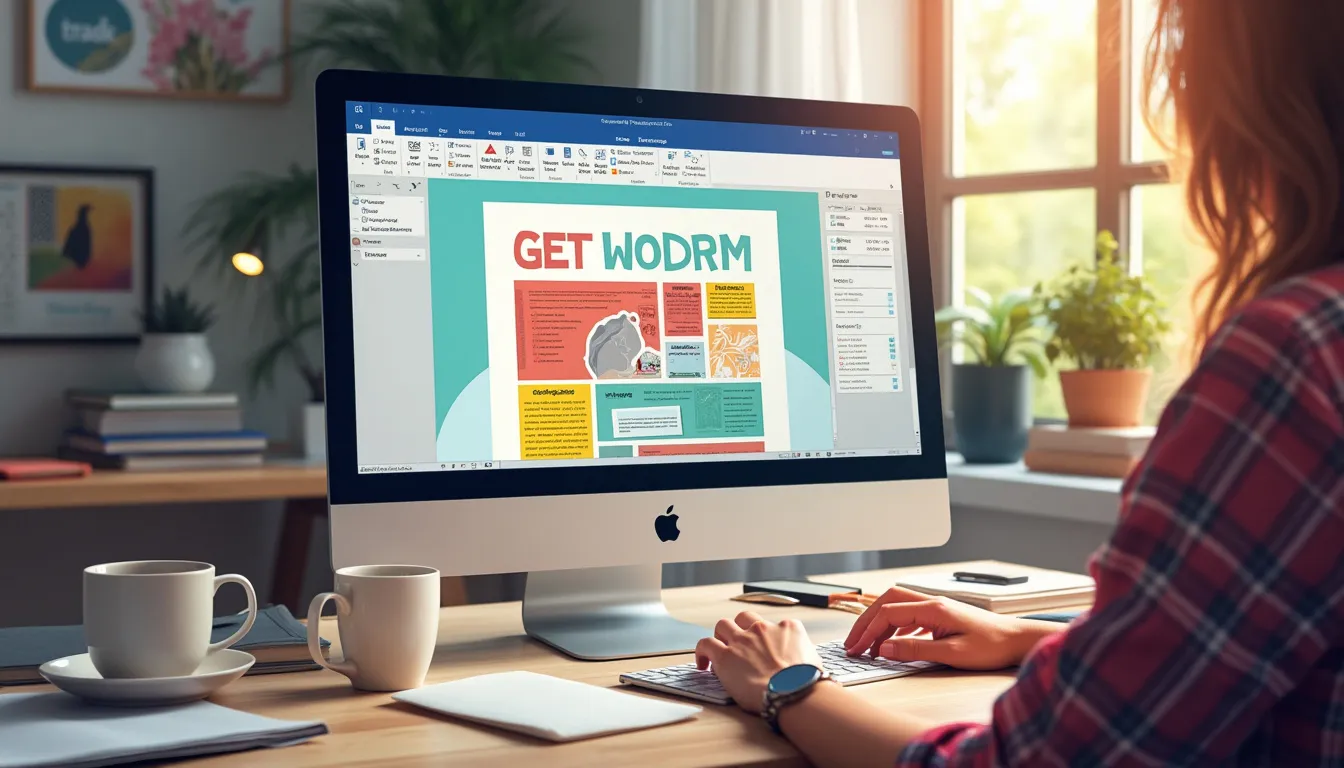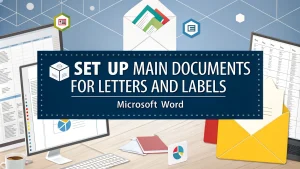Last Updated: January 24, 2025
Are you tired of spending countless hours formatting documents from scratch each time you need to create one? If so, you’re not alone. Many professionals struggle with maintaining efficiency while trying to present their work in a polished, professional manner.
That’s where the power of creating custom templates in Microsoft Word comes into play! Custom templates not only save you time but also help ensure consistency and professionalism across all your documents.
In this step-by-step guide, you will learn how to create custom templates in Microsoft Word that cater specifically to your needs. From selecting the perfect layout to customizing styles, fonts, and formatting, you’ll gain invaluable insights into the entire process.
We will also cover essential tips and best practices that will empower you to design user-friendly templates suitable for various purposes, such as resumes, business letters, and reports.
Whether you’re a student, a small business owner, or someone who frequently drafts documents, custom templates can revolutionize the way you work. By the end of this guide, you’ll be equipped with the skills to create stunning templates that resonate with your audience and streamline your workflow. So, let’s dive in and start transforming your document creation process today!
Table Of Contents
- 1 Why You should Create Custom Templates
- 2 Key Benefits at a Glance
- 3 How Custom Templates Enhance Your Workflow
- 4 Emotional Impact of Professional Documents
- 5 Overview of the Process
- 6 Frequently Asked Questions about Creating Custom Templates
- 7 A Quick Call to Action
- 8 Step-by-Step Instructions for Creating Custom Templates in Microsoft Word
- 9 Tips and Best Practices for Effective Custom Templates
- 10 Conclusion
Why You should Create Custom Templates
Creating custom templates in Microsoft Word can significantly enhance your productivity and overall professionalism in written communications. Whether you’re crafting business documents, resumes, or reports, using templates can save you time and effort, allowing you to focus on the content rather than the layout. Here’s why they are crucial:
- Time-Saving: Templates streamline your workflow by providing a predefined structure. This means less time spent on formatting and more on crafting compelling content.
- Consistency: Custom templates ensure that your documents maintain a consistent look and feel, which enhances your brand identity, especially in a business context.
- Professionalism: Well-designed templates can make a positive impression on your audience, showcasing your attention to detail and professionalism.
- Reduced Errors: By using a template, you minimize the risk of formatting mistakes, ensuring that your documents appear polished and error-free every time.
Key Benefits at a Glance
Let’s break down the benefits of creating custom templates in Microsoft Word into easily digestible points:
| Benefit | Description |
|---|---|
| Efficiency | Quickly create documents without starting from scratch. |
| Brand Image | Reflects your organization’s branding through consistent styling. |
| Collaboration | Facilitates teamwork by providing a uniform format for all members. |
| Ease of Use | User-friendly, allowing even tech novices to produce well-structured documents. |
How Custom Templates Enhance Your Workflow
Imagine you frequently write business reports or proposals. Instead of formatting each report from scratch, having a custom template set up with headings, footers, and branding elements will allow you to fill in the necessary information simply. This not only speeds up the process but also ensures that you follow a standardized format that is familiar to your audience.
Emotional Impact of Professional Documents
It’s important to remember that the way a document looks can affect how it’s received. An aesthetically pleasing, well-organized document is more likely to engage your reader and leave a lasting impression. Not only does this showcase professionalism, but it can also instill trust and confidence in your abilities—key factors in any business relationship.
Overview of the Process
Creating custom templates in Microsoft Word is straightforward and involves a few essential steps. Here’s a brief overview of what readers can expect to learn:
- Choosing the Right Layout: Start by selecting a document layout that aligns with your goals.
- Customizing Styles, Fonts, and Formatting: Tailor your template to fit your personal or organizational branding.
- Saving and Managing Templates: Ensure your templates are easy to access and organize for future use.
These steps will not only equip you with technical skills but also empower you to create documents that represent your work at a high standard.
Frequently Asked Questions about Creating Custom Templates
What types of custom templates can I create?
Your creativity is the limit! Some popular choices include:
- Resumes
- Cover letters
- Business letters
- Project proposals
- Meeting agendas
Do I need advanced skills to create custom templates?
No, you don’t need advanced skills! Microsoft Word’s user-friendly interface makes it accessible to everyone. A bit of practice, and you’ll be well on your way to creating effective custom templates.
Absolutely. Creating and sharing templates can foster collaboration in your team or organization. Just save your template file and send it to your colleagues, or upload it to a shared drive for easy access!
A Quick Call to Action
If you’re ready to enhance your productivity and professionalism by creating your own templates, stay tuned for the next section. We’ll dive into the step-by-step process that will enable you to get started quickly and effectively!

Step-by-Step Instructions for Creating Custom Templates in Microsoft Word
A. Starting a New Document and Choosing the Right Layout
Creating custom templates in Microsoft Word begins with selecting the right document type. Start by opening Microsoft Word and clicking on Blank Document. This basic starting point allows you to customize every aspect according to your needs.
When it comes to layout, your choices will define the functionality and appearance of your template. For example, if you’re designing a resume, consider the layout that best showcases your skills and experiences. Here’s a quick list of layout types you can explore:
- Single-column layout for resumes and cover letters.
- Multi-column layouts for newsletters and reports.
- Custom page sizes for invitations or brochures.
After choosing the layout, set your page orientation—landscape or portrait—as per your requirements. You can do this by going to the Layout tab and selecting Orientation. With the right layout established, you’re ready to dive into customization!
B. Customizing Styles, Fonts, and Formatting for Your Template
Once your layout is finalized, it’s time to infuse your brand into your template through styles and formatting. This is where the magic happens, allowing you to create a truly unique document.
1. Choose the Right Fonts:
Select two to three complementary fonts for headings, subheadings, and body text. For professional documents, consider clean and readable fonts like Arial, Calibri, or Times New Roman. A common practice is to use a bold font for headings and a regular font for body text, ensuring easy readability.
2. Set Up Styles:
In Word, styles can streamline your formatting process significantly. Go to the Home tab, select Styles, and create a new style for headings, subheadings, and text. This makes it easy to apply consistent formatting all over your template.
3. Add Color and Graphics:
Choose a color palette that resonates with your brand. You can change the color of your text and background by going to the Design tab, selecting Colors, and picking a custom theme. You might also want to include your logo or relevant graphics. Insert your logo by navigating to Insert > Pictures and resizing it accordingly.
4. Utilize Tables and Lists:
If your template requires organized data, incorporate tables or lists. For instance, using a table in a report can assist in breaking down information seamlessly, making it more digestible for the reader. You can create a table by going to Insert > Table and choosing the number of rows and columns you need.
5. Incorporate Placeholders:
Placeholders help guide users on where to insert information in the document. For example, in a business letter template, add a line like [Your Name] that prompts the user to enter their name. Use [brackets] to indicate placeholders clearly.
C. Saving and Managing Your Templates for Easy Access
The final step in creating custom templates in Microsoft Word is to save and manage them efficiently. This ensures you can quickly access your templates when needed.
1. Save Your Template:
Once you’re satisfied with your design, it’s crucial to save your document as a template. Click on File, then Save As. In the Save as type dropdown menu, select Word Template (*.dotx). This file type allows you to use the document as a template in the future without altering the original design.
2. Naming Your Template:
When saving, be sure to give your template a descriptive name. For example, Professional Resume Template is more informative than Template 1. This makes searches in your document library much easier.
3. Managing Your Templates:
To manage your templates efficiently, consider organizing them into folders based on category (e.g., resumes, business letters, reports). You can find your saved templates by navigating to File, clicking on New, and then accessing Personal to see all your custom templates.
4. Accessing Custom Templates:
Whenever you want to use a template, open Word and go to New, where you will find all your saved templates listed. Simply click on the one you want, and it will open as a new document, ready for you to personalize.
5. Updating Templates:
Remember, your templates can evolve with time. If you make changes to your branding or design standards, revisit your saved templates and update them. Just open the template file, apply your desired changes, and save it again.
By following these steps, you will not only create effective custom templates in Microsoft Word but also streamline your workflow, enhancing both professionalism and efficiency. With practice, creating templates will become a breeze, giving you more time to focus on what truly matters—producing high-quality content!

Tips and Best Practices for Effective Custom Templates
Keep Your Templates User-Friendly and Consistent
When creating custom templates in Microsoft Word, the golden rule is to maintain user-friendliness. A well-structured template not only saves time but also enhances productivity. Here are key tips to ensure your template is accessible and easy to use:
1. Clear Instructions: Consider adding a brief guide for users. Placing them in the header or footer can provide essential insights on how to fill in the template without cluttering the main content. For example, you could label sections as “Insert Name Here” or “Add Project Details” with highlighted text.
2. Logical Layout: Divide the template into distinct sections with clear headings. This segmentation allows users to navigate through the document with ease. Utilizing headings and subheadings (like H1, H2, and H3) will help create a structured feel, making the document more visually appealing.
3. Consistent Formatting: Whether you opt for bold text for headings or a unique color for important notes, be consistent throughout the template. Inconsistencies can confuse users and diminish the professional appearance of your documents.
4. Limit Options: Providing too many choices for fonts, colors, or layouts can overwhelm users. Stick to a few styles that align with your branding, and maintain uniformity across templates to promote professionalism.
Adhering to these practices enhances usability, ensuring that anyone who uses your template can do so confidently and effectively.
Suggestions for Types of Templates
Creating custom templates in Microsoft Word can significantly streamline various tasks, especially when you tailor them to common documentation needs. Here are some popular categories and their unique benefits:
1. Resumes: A well-designed resume template can help individuals present their professional experience effectively. Ensure that it highlights sections such as work experience, skills, and education with adequate spacing and smart use of bullet points.
2. Business Letters: Professional communication is crucial for maintaining business relationships. Design a business letter template that includes your logo, contact information, and clearly defined sections such as the date, recipient’s address, salutation, body, and closing.
3. Reports: Whether for academic or business purposes, creating a report template can save time. Include a title page, table of contents, executive summary, and clearly defined sections for analysis. This adherence to structure helps convey information effectively.
4. Proposals: A proposal template can greatly enhance your chances of winning contracts. Design yours with sections for introduction, objectives, methodologies, timelines, and budgets.
5. Invoices: Streamlining the billing process with a custom invoice template ensures you get paid promptly. Include sections for client information, services rendered, payment terms, and a breakdown of costs.
By tailoring templates to these specific needs, you maximize efficiency and meet varying documentation standards.
Troubleshooting Common Issues When Creating Templates
Even the most skilled Word users can encounter challenges when creating custom templates. Here are some common issues and solutions to keep your workflow smooth:
1. Formatting Issues: Users often report unexpected formatting changes when applying different styles. To avoid this, use the “Format Painter” feature to easily transfer formatting styles between texts. Additionally, ensuring that all text in your templates uses a consistent style set can mitigate formatting troubles.
2. Template Not Saving Correctly: If your custom template isn’t saving as expected, double-check the file format. Always select ‘Word Template’ (.dotx) from the ‘Save as type’ dropdown menu to ensure it retains the template structure.
3. Inconsistent Styles Across Devices: Different Microsoft Word versions might affect the appearance of your templates. To counter this, consider testing your template on multiple devices and Word versions. Always create templates in the latest version available for maximum compatibility.
4. Content Overlaps: If text or graphics overlap, check the layout options. Make sure your template uses text boxes and shape options correctly. This correction will often resolve unseen issues related to margins or spacing.
Addressing these common pitfalls proactively helps ensure that your custom templates in Microsoft Word function seamlessly and reduce frustration for end users.
By following these best practices, you can enhance the quality and efficiency of your custom templates, making the creation process smoother and more effective. With a little care and attention to detail, your templates can serve as powerful tools that stand the test of time and usage.
Conclusion
Creating custom templates in Microsoft Word is not only a valuable skill but also a significant step towards enhancing your productivity and professionalism. By following the step-by-step guide provided, you can tailor documents to meet your specific needs, ensuring that each template serves its intended purpose while maintaining a consistent look and feel. Remember, the importance of templates lies in their ability to save you time and effort in the long run, allowing you to focus on what truly matters—your content.
As we’ve discussed, starting with a well-structured layout, customizing styles, fonts, and formats, and properly managing your templates will empower you to produce high-quality documents efficiently. Additionally, sticking to user-friendly designs and troubleshooting common issues can further enhance your template-creating experience. So whether you’re drafting a professional resume, a compelling business letter, or an organized report, having a collection of reliable templates is invaluable.
We encourage you to take action and begin creating your own custom templates today. Not only will you streamline your document creation process, but you’ll also impress colleagues, clients, and stakeholders with your polished and professional outputs. Embrace the potential of Microsoft Word, unlock creative possibilities, and elevate your work with tailored templates that reflect your unique style and requirements. Happy template designing!






Pingback: Microsoft OneNote for Students: Your Complete Study Companion | MSW Tutor.
Pingback: How To Create Custom Word Themes & Brand Style Sets In Word? | MSW Tutor.